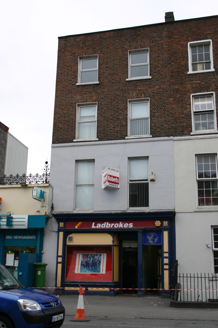Survey Data
Reg No
21517130
Rating
Regional
Categories of Special Interest
Architectural, Artistic
Original Use
House
In Use As
Office
Date
1830 - 1850
Coordinates
157248, 156502
Date Recorded
16/07/2005
Date Updated
--/--/--
Description
Terraced two-bay four-storey over concealed basement red brick house, built c. 1840, with a historic shopfront at ground floor level and a render finish to first floor level. Pitched roof hidden behind parapet wall to front and side elevation. Rendered chimneystack to north party wall. Red brick façade at second and third floor level laid in Flemish bond with cement re-pointing, terminating with a parapet wall with torch-on felt flashing to coping. Render finish at first floor level terminating beneath second floor sill level with a moulded rendered stringcourse. Plain cement rendered side elevation. Square-headed window openings with red brick flat arches and patent rendered reveals to second and third floor level, render reveals to first floor level, limestone sills throughout and uPVC windows. Late nineteenth-century timber shopfront comprising: panelled end pilasters terminating a fascia board with a dentil enriched cornice; original display window above panelled stall riser, with original window frame having spandrel panels to upper corners and returning from a colonnette glazing bar to form one side of a recessed entrance porch; timber-panelled porch screen separating entrance to upper floors; original flat-panelled timber door with horizontal upper floors. Front site basement area covered over.
Appraisal
Forming one of two houses compositionally united by a fenestration alignment, unified parapet wall and a render finish terminating at second floor level with a moulded stringcourse. This house is enriched by the addition of a late nineteenth century timber shopfront. The west side of Quinlan Street is not, as one would expect, enclosed by a terrace of similarly scaled houses, as two nineteenth century single-storey structures occupy two plots of the terrace. While a fully enclosed streetscape may not have been formally planned, it must surely have been intended given the prevailing zeitgeist of regular uniform terrace urban development and the thriving speculative building market of the mid nineteenth century. The result in this case is the relative isolation of this pair of houses, which are dramatically taller than the pair of neighbouring single-storey buildings to the south.





